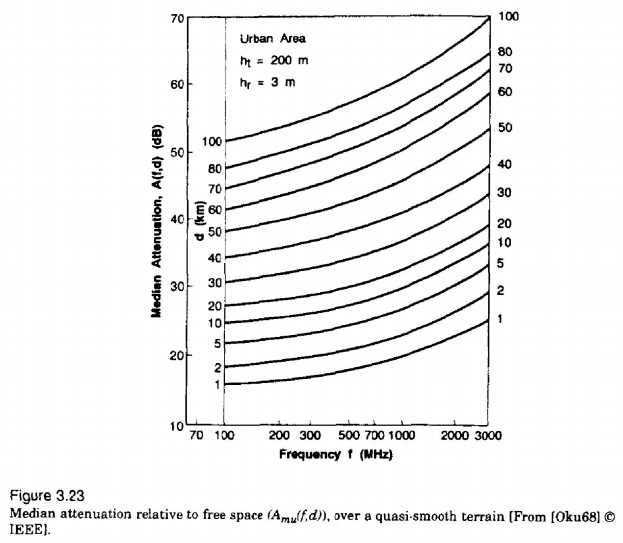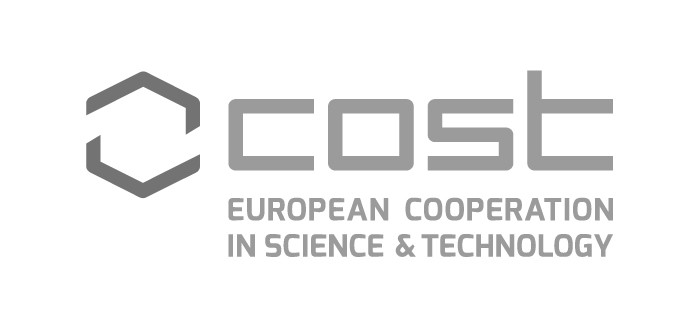|
Cost 231 Model
The COST Hata model is a radio propagation model (i.e. path loss) that extends the urban Hata model (which in turn is based on the Okumura model) to cover a more elaborated range of frequencies (up to 2 GHz). It is the most often cited of the COST 231 models (EU funded research project ca. April 1986 – April 1996), also called the ''Hata Model PCS Extension''. This model is the combination of empirical and deterministic models for estimating path loss in an urban area over frequency range of 800 MHz to 2000 MHz. (COopération européenne dans le domaine de la recherche Scientifique e ... [...More Info...] [...Related Items...] OR: [Wikipedia] [Google] [Baidu] |
Radio Propagation Model
Radio propagation is the behavior of radio waves as they travel, or are propagated, from one point to another in vacuum, or into various parts of the atmosphere. As a form of electromagnetic radiation, like light waves, radio waves are affected by the phenomena of reflection, refraction, diffraction, absorption, polarization, and scattering. Understanding the effects of varying conditions on radio propagation has many practical applications, from choosing frequencies for amateur radio communications, international shortwave broadcasters, to designing reliable mobile telephone systems, to radio navigation, to operation of radar systems. Several different types of propagation are used in practical radio transmission systems. ''Line-of-sight propagation'' means radio waves which travel in a straight line from the transmitting antenna to the receiving antenna. Line of sight transmission is used for medium-distance radio transmission, such as cell phones, cordless phones, walkie-tal ... [...More Info...] [...Related Items...] OR: [Wikipedia] [Google] [Baidu] |
Hata Model
The Hata model is a radio propagation model for predicting the path loss of cellular transmissions in exterior environments, valid for microwave frequencies from 150 to 1500 MHz. It is an empirical formulation based on the data from the Okumura model, and is thus also commonly referred to as the Okumura–Hata model. The model incorporates the graphical information from Okumura model and develops it further to realize the effects of diffraction, reflection and scattering caused by city structures. Additionally, the Hata Model applies corrections for applications in suburban and rural environments. Model description Though based on the Okumura model, the Hata model does not provide coverage to the whole range of frequencies covered by Okumura model. Hata model does not go beyond 1500 MHz while Okumura provides support for up to 1920 MHz. The model is suited for both point-to-point and broadcast communications, and covers mobile station antenna heights of 1–10 m, base station a ... [...More Info...] [...Related Items...] OR: [Wikipedia] [Google] [Baidu] |
Okumura Model
The Okumura model is a radio propagation model that was built using the data collected in the city of Tokyo, Japan. The model is ideal for using in cities with many urban structures but not many tall blocking structures. The model served as a base for the Hata model. Okumura model was built into three modes. The ones for urban, suburban and open areas. The model for urban areas was built first and used as the base for others. Coverage Frequency = 150–1920 MHz Mobile station antenna height: between 1 m and 3 m Base station antenna height: between 30 m and 100 m Link distance: between 1 km and 100 km Mathematical formulation The Okumura model is formally expressed as: L\;=\;L_\text\;+\;A_\text\;-\;H_\text\;-\;H_\text\;-\;\sum\; where, L = The median path loss. Unit: Decibel (dB) LFSL = The free space loss. Unit: decibel (dB) AMU = Median attenuation. Unit: decibel (dB) HMG = Mobile station antenna height gain factor. HBG = Base station antenna height gai ... [...More Info...] [...Related Items...] OR: [Wikipedia] [Google] [Baidu] |
European Cooperation In Science And Technology
The European Cooperation in Science and Technology (COST Association) is running an EU-funded programme which enables researchers and innovators to set-up their own research networks in a wide range of scientific topics, called COST Actions. While COST does not fund research activities as such, it provides funding for scientific collaboration in the form of conferences, meetings, training schools and scientific exchanges. To date, COST has 38 Full Members, 1 Cooperating Member and 1 Partner Member. Prof. Alain Beretz is currently serving as the President of the COST Association, following his appointment in June 2021. History In the 1960s, European countries felt the need to begin framing science policies in order to bridge the gap in science and technology between Europe and the USA. As a result, COST was founded in 1971 to connect the research systems of individual European countries. The Ministerial Conference of 22 and 23 November 1971 is generally presented as the official ... [...More Info...] [...Related Items...] OR: [Wikipedia] [Google] [Baidu] |
Mobile Station
A mobile station (MS) comprises all user equipment and computer software, software needed for communication with a Cellular network, mobile network. The term refers to the global system connected to the mobile network, i.e. a mobile phone or mobile computer connected using a mobile broadband adapter. This is the terminology of 2G systems like GSM. In 3G systems, a mobile station (MS) is now referred to as user equipment (UE). In GSM, a mobile station consists of four main components: *Mobile termination (MT) - offers common functions such as: radio Transmission (telecommunications), transmission and Handoff, handover, Speech coding, speech encoding and decoding, error detection and correction, Signaling (telecommunications), signalling and access to the SIM. The IMEI code is attached to the MT. It is equivalent to the network termination of an Integrated services digital network, ISDN access. *Terminal equipment (TE) - is any device connected to the MS offering services to the u ... [...More Info...] [...Related Items...] OR: [Wikipedia] [Google] [Baidu] |
Antenna (radio)
In radio engineering, an antenna or aerial is the interface between radio waves propagating through space and electric currents moving in metal conductors, used with a transmitter or receiver. In transmission, a radio transmitter supplies an electric current to the antenna's terminals, and the antenna radiates the energy from the current as electromagnetic wave In physics, electromagnetic radiation (EMR) consists of waves of the electromagnetic (EM) field, which propagate through space and carry momentum and electromagnetic radiant energy. It includes radio waves, microwaves, infrared, (visib ...s (radio waves). In Receiver (radio), reception, an antenna intercepts some of the power of a radio wave in order to produce an electric current at its terminals, that is applied to a receiver to be Amplifier, amplified. Antennas are essential components of all radio equipment. An antenna is an array of conductor (material), conductors (Driven element, elements), elect ... [...More Info...] [...Related Items...] OR: [Wikipedia] [Google] [Baidu] |
Base Station
Base station (or base radio station) is – according to the International Telecommunication Union's (ITU) Radio Regulations (RR) – a "land station in the land mobile service." The term is used in the context of mobile telephony, wireless computer networking and other wireless communications and in land surveying. In surveying, it is a GPS receiver at a known position, while in wireless communications it is a transceiver connecting a number of other devices to one another and/or to a wider area. In mobile telephony, it provides the connection between mobile phones and the wider telephone network. In a computer network, it is a transceiver acting as a switch for computers in the network, possibly connecting them to a/another local area network and/or the Internet. In traditional wireless communications, it can refer to the hub of a dispatch fleet such as a taxi or delivery fleet, the base of a TETRA network as used by government and emergency services or a CB shack. Land s ... [...More Info...] [...Related Items...] OR: [Wikipedia] [Google] [Baidu] |
Median
In statistics and probability theory, the median is the value separating the higher half from the lower half of a data sample, a population, or a probability distribution. For a data set, it may be thought of as "the middle" value. The basic feature of the median in describing data compared to the mean (often simply described as the "average") is that it is not skewed by a small proportion of extremely large or small values, and therefore provides a better representation of a "typical" value. Median income, for example, may be a better way to suggest what a "typical" income is, because income distribution can be very skewed. The median is of central importance in robust statistics, as it is the most resistant statistic, having a breakdown point of 50%: so long as no more than half the data are contaminated, the median is not an arbitrarily large or small result. Finite data set of numbers The median of a finite list of numbers is the "middle" number, when those numbers are list ... [...More Info...] [...Related Items...] OR: [Wikipedia] [Google] [Baidu] |
Path Loss
Path loss, or path attenuation, is the reduction in power density (attenuation) of an electromagnetic wave as it propagates through space. Path loss is a major component in the analysis and design of the link budget of a telecommunication system. This term is commonly used in wireless communications and signal propagation. Path loss may be due to many effects, such as free-space loss, refraction, diffraction, reflection, aperture-medium coupling loss, and absorption. Path loss is also influenced by terrain contours, environment (urban or rural, vegetation and foliage), propagation medium (dry or moist air), the distance between the transmitter and the receiver, and the height and location of antennas. Causes Path loss normally includes ''propagation losses'' caused by the natural expansion of the radio wave front in free space (which usually takes the shape of an ever-increasing sphere), ''absorption losses'' (sometimes called penetration losses), when the signal passes thro ... [...More Info...] [...Related Items...] OR: [Wikipedia] [Google] [Baidu] |
Decibel
The decibel (symbol: dB) is a relative unit of measurement equal to one tenth of a bel (B). It expresses the ratio of two values of a power or root-power quantity on a logarithmic scale. Two signals whose levels differ by one decibel have a power ratio of 101/10 (approximately ) or root-power ratio of 10 (approximately ). The unit expresses a relative change or an absolute value. In the latter case, the numeric value expresses the ratio of a value to a fixed reference value; when used in this way, the unit symbol is often suffixed with letter codes that indicate the reference value. For example, for the reference value of 1 volt, a common suffix is " V" (e.g., "20 dBV"). Two principal types of scaling of the decibel are in common use. When expressing a power ratio, it is defined as ten times the logarithm in base 10. That is, a change in ''power'' by a factor of 10 corresponds to a 10 dB change in level. When expressing root-power quantities, a change in ''ampl ... [...More Info...] [...Related Items...] OR: [Wikipedia] [Google] [Baidu] |
Megahertz
The hertz (symbol: Hz) is the unit of frequency in the International System of Units (SI), equivalent to one event (or Cycle per second, cycle) per second. The hertz is an SI derived unit whose expression in terms of SI base units is s−1, meaning that one hertz is the reciprocal of one second. It is named after Heinrich Hertz, Heinrich Rudolf Hertz (1857–1894), the first person to provide conclusive proof of the existence of electromagnetic waves. Hertz are commonly expressed in metric prefix, multiples: kilohertz (kHz), megahertz (MHz), gigahertz (GHz), terahertz (THz). Some of the unit's most common uses are in the description of periodic waveforms and musical tones, particularly those used in radio- and audio-related applications. It is also used to describe the clock speeds at which computers and other electronics are driven. The units are sometimes also used as a representation of the photon energy, energy of a photon, via the Planck relation ''E'' = ''hν'', ... [...More Info...] [...Related Items...] OR: [Wikipedia] [Google] [Baidu] |
Antenna (radio)
In radio engineering, an antenna or aerial is the interface between radio waves propagating through space and electric currents moving in metal conductors, used with a transmitter or receiver. In transmission, a radio transmitter supplies an electric current to the antenna's terminals, and the antenna radiates the energy from the current as electromagnetic wave In physics, electromagnetic radiation (EMR) consists of waves of the electromagnetic (EM) field, which propagate through space and carry momentum and electromagnetic radiant energy. It includes radio waves, microwaves, infrared, (visib ...s (radio waves). In Receiver (radio), reception, an antenna intercepts some of the power of a radio wave in order to produce an electric current at its terminals, that is applied to a receiver to be Amplifier, amplified. Antennas are essential components of all radio equipment. An antenna is an array of conductor (material), conductors (Driven element, elements), elect ... [...More Info...] [...Related Items...] OR: [Wikipedia] [Google] [Baidu] |






.jpg)
